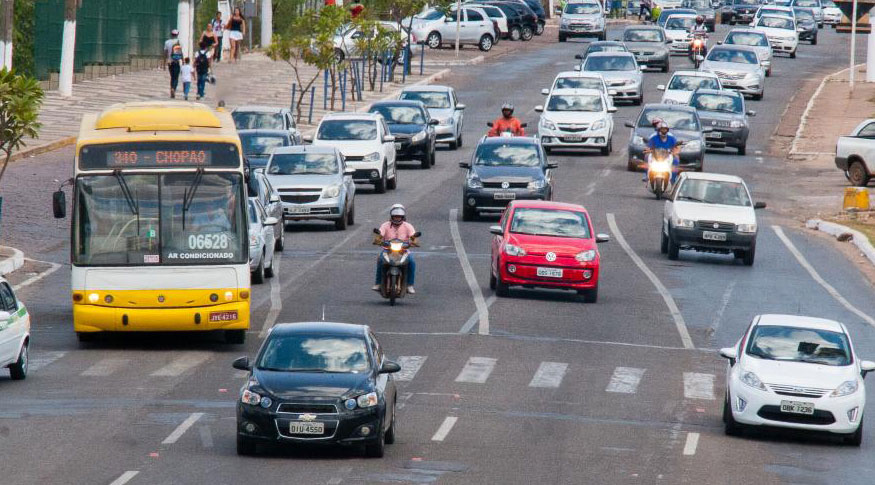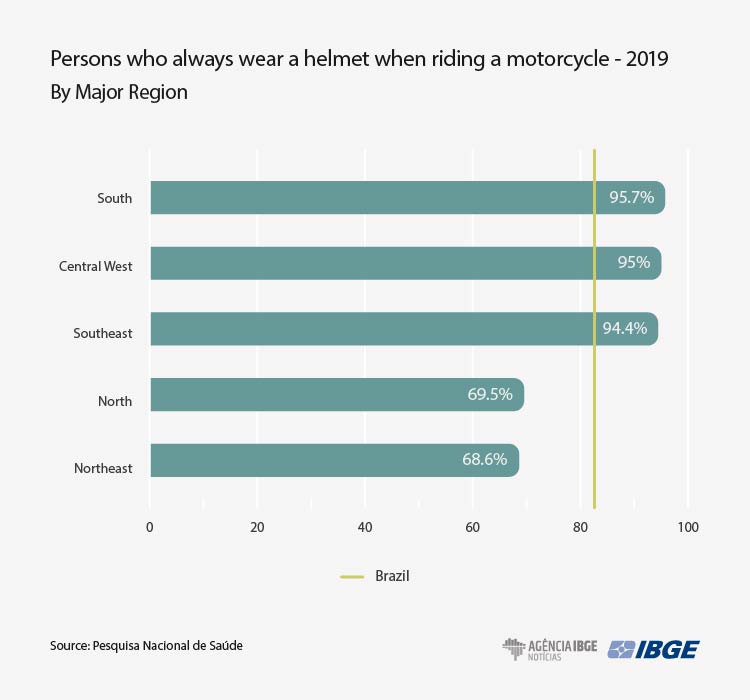National Survey of Health
Only 54.6% of the adults wore a seat belt in when in the back seat of the car in 2019
May 07, 2021 10h00 AM | Last Updated: May 09, 2021 09h06 PM
Highlights
- Four out of every five persons aged 18 and over, in 2019, reported always wearing a seat belt in the front seat of the car as drivers or passengers of a car, a total of 79.7%;
- Men are a little more resistant against the measure (77.7% against 81.5% of women);
- Youngsters also wore a little less of the seat belt. The lowest percentage was found among persons aged 18 to 29 years of age, 71.1%;
- In the urban area, 82.6% reported wearing a seat belt, versus 61.1% in the rural area;
- As for use in the back seat of the car, the rate was 54.6%. And the index was even lower in the rural area (49.7% versus 55.4% in the urban area);
- Among those who reported riding a motorcycle, 82.6% always wore a helmet. The highest index was found among persons with a higher level of schooling (91.6%) and the lowest, among those without schooling or with incomplete elementary education (74.4%). In the rural area, the rate was 60.7%, whereas in the urban area, it was 89.2%;
- 70% of the drivers said they never used the cell phone while driving. However, 30% used to do it: seldom (13.9%), sometimes (10.6%), very often (2.4%) or always (3.1%), resulting in risk of an accident;
- More than half (59,5%) of the car accidents resulting in bodily injury affected those riding a motorcycle. Cars accounted for 31.0% of the accidents;
- About 3.9 million persons, or 2.4% of the population, reported having had a car accident in the period of 12 months prior to the interview;
- Approximately 2.6 million persons older than 18 years of age, or 2.6% of the persons working in the week of reference, reported having had some type of work accident. From that total, the percentage of men, 68.7% was more than twice that of women, 31.3%.

Four out of every five persons aged 18 and over reported, in 2019, wearing a seat bel in the front seat when driving or as passengers of a car. That percentage, 79.7%, decreases when the back seat is considered: 54.6%. Data comes from the National Survey of Health 2019 – Accidents, Violence, Sexually-Tranmitted Diseases, Sexual Life, Characteristics of Labor and Social Support, released today (07) by the IBGE, in partnership with the Ministry of Health.
Although widespread in the country, the use of a seatbelt in the front seat varies significantly depending on the aspect analyzed. Men are more resistant to that measure: 77.7% reported always wearing it versus 81.5% of women. In terms of age, the difference is even bigger. Youngsters wearing the seat belt in the front seat make up the lowest percentage: 71.1% among persons aged 18 to 29. Considering persons aged 60 and over, the figure was 84.8%. The difference increases when location is considered. In the urban area, 82.6% reported adopting that measure, whereas in the urban area, only 61.1% did.

By area, the lowest indexes were recorded by the North (69.5%) and Northeast (69.7%), whereas the highest ones were those in the Southeast (85.4%), South (84.6%) and Central West (81.8%). “There has been consistent adherence to the idea of wearing a seat belt when in the front seat since the implementation of the Brazilian Traffic Code, in 1997, when use became compulsory. That habit has been part of people’s everyday life”, says Flávia Vinhaes, analyst of the survey, as she calls attention to differences between the several scopes of analysis.
The use of a belt in the back seat is less well-accepted. The index is even lower in the rural area (49.7% versus 55.4% in the urban area). Regional differences are also relevant: the lowest rate is that in the North (43.4%) and the highest, in the South (67.5%), a difference of more than 20 percentage points.
Fewer motorcyclists in the North and Northeast wear a helmet
The survey also shows that, among persons who rode motorcycles, 82.6% used to wear a helmet. The index is highest among persons with a higher level of schooling, and reaches 91.6% among those with higher education, whereas persons without instruction or with incomplete elementary education (74.4%) it is below the national average. Similarly to the use of a seat belt, there is a clear distinction concerning the habit of wearing a helmet among residents of rural areas (60.7%) compared to those of urban ones (89.2%).
Among the Major Regions, the South (95.7%), the Central West (95.0%) and the Southeast (94.4%) had the highest percentages of use of helmets. The North (69.5%) and Northeast (68.6%) registered the biggest proportions.

More than half (59.5%) of the accidents resulting in bodily injury involved persons riding a motorcycle, whereas cars accounted for 31.0% of the accidents. In 9.5% of the times, the accident involved other means of transportation, such as bicycles, buses of trucks.
In 2019, about 3.9 million persons, or 2.4% of the population, said they had suffered a traffic accident in the period of 12 months prior to the survey. In the North (3.4%) and in the Central West (3.2%) the percentage is above the national average.
Among persons involved in a car accident with bodily injury, almost half (48%) had to stop their daily activities. Other 60.6% needed some medical assistance after the accident, whereas 14.9% had permanent physical aftereffects as a result of the accident, being men the majority in this group (63.3% versus 36.7%).
"Traffic accidents are one of the main causes of death worldwide. So, they are a problem in public health. Lesions resulting from them cause sequelae like motor disability. It is vital that people use safety equipment in order to reduce such impacts, Ms. Vinhaes says.
Also according to the survey, 70% of the drivers reported never using a cell phone while driving. However, 30% did it seldom (13.9%), sometimes (10.6%), very often (2.4%) or always (3.1%), being in risk of an accident.

Men suffered more work accidents than women in 2019
PNS 2019 also dealt with workplace safety and revealed that women were less involved in this type of accident. In 2019, about 2.6 million persons over 18 years of age, or 2.6% of the persons working in the week of reference, reported suffering some type of accident at work. Men were 68.7% and women, 31.3%. Among those 2.6 million persons, 48% interrupted their daily activities and 2.7% had permanent physical aftereffects as a result of the accident.




















